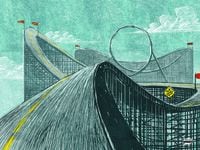Not much matches the thrill of acing a complicated series of corners. Part of the satisfaction comes from seamlessly executing the cornering process: setting perfect entry speed, establishing precise lean angle, and accelerating confidently toward the next bend. The perfect sequence of curves takes sharp cornering skills but also the ability to identify clues that uncover critical corner characteristics, including radius, camber, and pavement condition.
A surefire way to mess up a corner is to enter too fast. You can avoid this embarrassment by looking well ahead to pinpoint the corner radius and shape. There are three basic types of corners: constant-radius corners that have a constant arc from beginning to end; increasing-radius turns that begin tight but then gradually open up; and decreasing-radius turns that get tighter from entry to exit. Decreasing-radius turns are the most challenging corner type because you need to add more lean angle as you go. You can enter constant- and increasing-radius turns at moderately high speeds, but you’re going to want to slow down more for decreasing-radius turns.
The trick for determining the likely radius of a corner is knowing what to look for. Treetops, power lines, and guardrails are clues you can use to determine general direction, but they don’t always mirror the precise curve of the road. A more reliable way of determining where the road is headed is to identify the visual vanishing point of the painted centerline and fog lines as they recede into the distance. If these parallel lines converge in the near distance, expect the corner radius to tighten up. If the lines meet farther down the road, expect the radius to increase and the turn to become easier. Use the pavement edges as reference points if there are no painted lines.
Clues about corner radius and shape are the most critical, but you also need to identify surface camber because traction and cornering clearance are affected by whether the pavement is banked or sloping away. Positive corner camber (like the high banks of Daytona) allows your tires to press firmly into the pavement for maximum traction. It also provides increased cornering clearance when your bike is leaned. Off-camber (or negative-camber) offers less grip and decreased cornering clearance as the pavement drops away. Determine camber by using the same vanishing-point method. If the painted lines converge in the near distance, then the road camber is sloping away, but expect positive banking if the lines visually join farther down the road.
A complex series of corners often include each of the three corner types, with random variations in camber. An example would be a constant-radius left-hand turn followed by a decreasing-radius right-hand turn. Throw in several more corners of varying direction, camber, and shape and you can find yourself in a tight spot. Crashes often occur when small mistakes compound into bigger and bigger problems with each additional corner. Arrest this cumulative problem before it gets out of hand by slowing down and looking well ahead for clues to help manage the next set of curves.
Clues about pavement conditions should be part of your awareness as well. Look for changes in pavement color that could indicate surface debris, such as mud, sand, gravel, or spilled fluids. Skid marks at the beginning of a corner may suggest a tightening radius or some other hazard. These clues should prompt you to reduce speed.
Identifying important characteristics is easy if the corner is wide open and you can see far ahead. But it’s harder to find clues if the corner is obscured by vegetation or a roadside object. If in doubt about the corner radius, camber, or condition, slow down. You can always get on the gas if the turn is easier than you first thought.











/cloudfront-us-east-1.images.arcpublishing.com/octane/FZXHNOQRNVA3BIDWAF46TSX6I4.jpg)
/cloudfront-us-east-1.images.arcpublishing.com/octane/JRSFLB2645FVNOQAZCKC5LNJY4.jpg)
/cloudfront-us-east-1.images.arcpublishing.com/octane/ITNLTIU5QZARHO733XP4EBTNVE.jpg)
/cloudfront-us-east-1.images.arcpublishing.com/octane/VZZXJQ6U3FESFPZCBVXKFSUG4A.jpg)
/cloudfront-us-east-1.images.arcpublishing.com/octane/QCZEPHQAMRHZPLHTDJBIJVWL3M.jpg)
/cloudfront-us-east-1.images.arcpublishing.com/octane/HXOUJXQWA5HBHGRO3EMJIGFMVI.jpg)

/cloudfront-us-east-1.images.arcpublishing.com/octane/3TIWWRV4JBBOLDVGRYECVVTA7Y.jpg)
/cloudfront-us-east-1.images.arcpublishing.com/octane/KIX5O23D5NAIBGFXBN3327DKZU.jpg)
/cloudfront-us-east-1.images.arcpublishing.com/octane/7GJYDUIPXRGMTMQKN6ONYOLBOU.jpg)
/cloudfront-us-east-1.images.arcpublishing.com/octane/MUQLOVLL2ZDGFH25ILABNBXKTI.jpg)
/cloudfront-us-east-1.images.arcpublishing.com/octane/TNOU5DNE2BC57MFPMGN2EIDXAM.jpg)
/cloudfront-us-east-1.images.arcpublishing.com/octane/GTCXACQGJ5HAPDTGWUQKDEH44E.jpg)
/cloudfront-us-east-1.images.arcpublishing.com/octane/S35YGSEMEZB4BLTDJTSZPF4GLA.jpg)
/cloudfront-us-east-1.images.arcpublishing.com/octane/5UOT6HPX2JFMRJAX6EH45AR4MQ.jpg)
/cloudfront-us-east-1.images.arcpublishing.com/octane/OKWOJWAKP5EP3OACCRRWPCIX2Q.jpg)
/cloudfront-us-east-1.images.arcpublishing.com/octane/2WF3SCE3NFBQXLDNJM7KMXA45E.jpg)
/cloudfront-us-east-1.images.arcpublishing.com/octane/G4MG6OUCJNBSHIS2MVVOTPX65E.jpg)
/cloudfront-us-east-1.images.arcpublishing.com/octane/IIGGWFOTOJGB7DB6DGBXCCMTDY.jpg)
/cloudfront-us-east-1.images.arcpublishing.com/octane/QSTCM6AVEZA5JJBUXNIQ3DSOF4.jpg)
/cloudfront-us-east-1.images.arcpublishing.com/octane/U4I7G625B5DMLF2DVIJDFZVV6M.jpg)
/cloudfront-us-east-1.images.arcpublishing.com/octane/B6XD6LS6IVCQPIU6HXDJSM3FHY.jpg)
/cloudfront-us-east-1.images.arcpublishing.com/octane/ICL63FEDDRDTTMINYICCEYGMDA.jpg)
/cloudfront-us-east-1.images.arcpublishing.com/octane/FCGZHQXRBZFLBAPC5SDIQLVF4I.jpg)